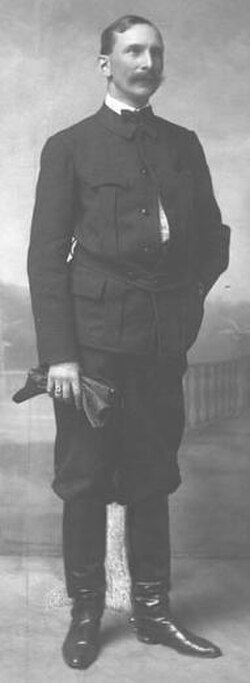Carl A. Schenck
| Carl A. Schenck | |
|---|---|

Carl Schenck in German riding costume, 1905
|
|
| Born | March 25, 1868 Darmstadt, Germany |
| Died |
May 17, 1955 (aged 87) Germany |
| Residence | Asheville, North Carolina; Hessen |
| Citizenship | Germany |
| Nationality | German |
| Fields | Forestry |
| Institutions | Biltmore Forest School |
| Alma mater | University of Giessen |
| Known for | Forester, George W. Vanderbilt's Biltmore Estate 1895-1909; Founder, Biltmore Forest School |
| Author abbrev. (botany) | C.A.Schenck |
Carl Alwyn Schenck (March 25, 1868 – May 17, 1955) was a pioneering forestry educator in North America, known for his contributions as the forester for George W. Vanderbilt's Biltmore Estate, and the founder of the Biltmore Forest School, the first practical forestry school in the United States, in 1898, near Brevard, NC.
Schenck was born in 1868 in the town of Darmstadt, Germany. From his youth he looked to forestry as a career, graduating from the Institute of Technology in Darmstadt at age 18. Two years later he enrolled for graduate study at the forest school of the University of Giessen. At Giessen he studied for a time under visiting professor Sir Dietrich Brandis, an influential German-born forester who had played a large part in introducing forestry into the British Empire, working in the forests of India and various other places. Brandis also had a great interest in forestry work in the United States. Schenck completed his Ph.D. degree at the beginning of 1895, and was at that time recommended by Brandis for a job in the United States working for George W. Vanderbilt. Schenck decided to accept the offer from Vanderbilt and sailed to America, arriving in New York City on April 5, 1895.
George W. Vanderbilt's Biltmore Estate near Asheville, North Carolina, included some 120,000 acres (490 km2) of mountain land. With these extensive forest land holdings, Vanderbilt had decided during the early 1890s that he wanted his forests managed using the best scientific principles of forestry. At this time there were only two trained foresters in the U.S.: American Gifford Pinchot and German Bernard Fernow. When Schenck arrived in America at Vanderbilt's request, he became the third.
Schenck took over the position of Biltmore Estate forester, and immediately got to work managing the vast land holdings. Schenck worked on various forest plantations, setting up tree nurseries, seed extraction and regeneration efforts, logging areas and sawmills, as well as splash dams and fish hatcheries in the rivers. Schenck used new scientific management and practical forestry techniques which had never before been applied to American forests.
...
Wikipedia
